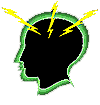 | Epilepsy |  |
 | Epilepsy |  |
Contents of this Page Types of Epilepsy Types of Epilepsy Causes Causes Diagnosis Diagnosis Treatment Treatment Famous People Famous People Organizations Organizations |
 Epilepsy is
NOT contagious and people with epilepsy are NOT "crazy." The word
"epilepsy" is derived from a Greek word meaning "to possess, seize or
hold." Changes in the way the brain processes electrical signals can
cause result in abnormal functioning. In people who have epilepsy,
cerebral cortical neurons misfire and result in seizures. This is similar to an electrical brainstorm.
The seizure prevents the brain from: Epilepsy is
NOT contagious and people with epilepsy are NOT "crazy." The word
"epilepsy" is derived from a Greek word meaning "to possess, seize or
hold." Changes in the way the brain processes electrical signals can
cause result in abnormal functioning. In people who have epilepsy,
cerebral cortical neurons misfire and result in seizures. This is similar to an electrical brainstorm.
The seizure prevents the brain from:
|
Types of EpilepsyThere are many types of epilepsy. Each type of epilepsy has different behavioral effects and is treated with different methods. In some cases, people know they are about to have a seizure because they see or hear something, or feel dizzy, nauseous, or "strange." This is called an aura. An aura can act as an "early warning system" telling a person that a seizure is about to happen. The person can therefore minimize a possible injury by taking precautions such as sitting down.
|
Causes Many (50-70%) cases of epilepsy have no known cause. For the remaining
cases, there are many other events that may cause epileptic seizures:
Many (50-70%) cases of epilepsy have no known cause. For the remaining
cases, there are many other events that may cause epileptic seizures:
Brain damage resulting from these events may cause a "scar" on the brain. This is where an epileptic seizure starts. At this time it is not known why a scar starts a seizure. There may be a genetic link for some types of epilepsy, but this is usually NOT the case. Sometimes a seizure will be started ("triggered") by:
|
DiagnosisA doctor will want to find out several things before a diagnosis of epilepsy is made. The doctor may want to know the answers to the following questions:
 An electroencephalogram
(EEG) is often used to help in the diagnosis of epilepsy. The EEG of
people with epilepsy often shows large spikes. Sometimes the EEG must be
recorded for a whole day in the hospital or at home because a short test
does not always pick up the abnormal activity. However, the EEG does not
always work because about 5% of people without epilepsy have
"abnormal" EEG activity and about 20% of people with epilepsy have
normal EEG activity. An electroencephalogram
(EEG) is often used to help in the diagnosis of epilepsy. The EEG of
people with epilepsy often shows large spikes. Sometimes the EEG must be
recorded for a whole day in the hospital or at home because a short test
does not always pick up the abnormal activity. However, the EEG does not
always work because about 5% of people without epilepsy have
"abnormal" EEG activity and about 20% of people with epilepsy have
normal EEG activity.Brain imaging methods (magnetic resonance imaging [MRI] or computer tomography [CT] scanning) may also be used to find the location of a scar or damaged brain tissue. Sometimes positron emission tomography [PET] is used to examine brain blood flow. |
Treatment for EpilepsyDrugs
Experimental TreatmentsSeveral treatments for epilepsy are still under investigation. How and if they work is still controversial.
| |||||||||||||||||||||||||||||||
| Epilepsy is a fairly common neurological disorder. It occurs in about 1 in every 100-200 people. Throughout history there have been many famous people who have had epilepsy: | |||
| Famous People with Epilepsy | |||
| Julius Caesar - Roman Statesman (100-44 B.C.) | Napoleon Bonaparte - Emperor of France (1769-1821) | 
| |
| George Frederick Handel - Composer (1685-1759) | Vincent van Gogh - Painter (1853-1890) | ||
| Fyodor Dostoevski - Writer (1821-1881) | Pius IX - Pope (1792-1878) | ||
| Peter the Great - Russian Czar (1682-1725) | Lord Byron - Poet (1788-1824) | ||
| Did you know? | Saint Valentine is the patron saint of epilepsy. |
| For more information on
epilepsy, see:
|
| Did you know?$ | The estimated annual national cost of epilepsy is reported to be approximately $12.5 billion. [Source: Epilepsy Foundation of America] |
| BACK TO: | Neurological and Mental Disorders | Exploring the Nervous System | Table of Contents |
![[email]](./gif/menue.gif) Send E-mail |
 Get Newsletter |
 Search Pages |